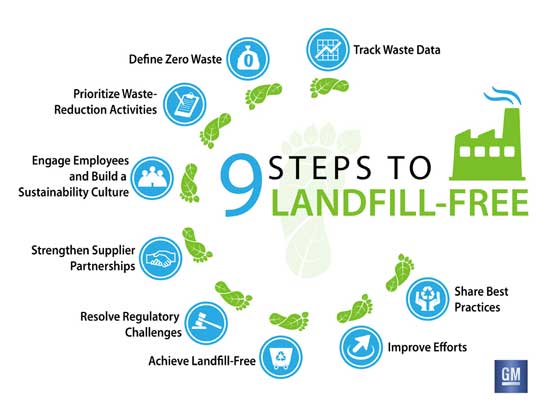10 things General Motors learned about going landfill-free

Getting to landfill-free is a challenging task. Over the years, however, we’ve developed best practices and are happy to share what’s worked for us. After all, it’s in everyone’s best interest to reduce the impact we have on the environment.
You candownload GM’s blueprintwith all the details. Here are 10 things we’ve learned along the way:
1. Track Waste Data:Put simply, we can’t manage what we don’t measure. Data tracking has allowed us to comprehend all materials generated, reused and recycled, helping us to set plant goals and metrics.
2. Define Zero Waste:There is no current industry standard for the term “zero waste,” and definitions can vary across companies. So, we identified criteria in which any future zero-waste facility needs to adhere.
3. Prioritize Waste-Reduction Activities:Prioritize projects that enable facility landfill-free designations, starting with: elimination of material, reusing it onsite and then offsite, recycling onsite and then offsite, composting, and converting to energy.
4. Engage Employees and Build a Sustainability Culture:We continue to help our employees envision other uses for material by creating rewards for new waste-reduction ideas and encourage them to develop job functions with the environment in mind. We also target certain byproduct streams for innovative waste-reduction projects and communicate the solutions.
5. Strengthen Supplier Partnerships:We developed a circle of eco-conscious parts suppliers and have resource managers – experts in waste elimination and reduction –assist at our sites.
6. Resolve Regulatory Challenges:Sometimes various government regulations require disposal of certain commodities, but solutions may exist to avoid landfilling. Therefore, we work with regulatory agencies to help them understand potential options for challenging waste streams and discuss ways to best manage them with sound scientific principles.
7. Achieve Landfill-Free:Once we’ve managed a significant amount of the facility’s byproducts without landfilling, we implement a procedure including full inventory of byproduct volumes and how they are managed. We then route the information to our landfill-free expert to assist in verification of the plan to eliminate all remaining byproducts from landfill. We request validation once it’s complete and communicate the achievement to our teams.
8. Improve Efforts:After an operation becomes landfill-free, our goal is to improve the waste performance to reduce environmental footprint and costs, and generate additional revenue. Continuously seeking improvement, we search for ways to design out waste versus reusing or recycling. Goal setting also helps us to encourage employees and maintain the momentum.
9. Share Best Practices:Helping others helps the environment as a whole, and ensures the robust infrastructure of effective partners necessary for all to succeed.
We discuss best practices as a team, and work together to brainstorm uses for challenging byproducts.
We provide other companies with facility tours and processes to offer ideas about how they can cut their landfill deposits.
We engage the community through activities such as litter cleanups and household waste recycling programs.
We participate in formal and informal external networking opportunities to identify and drive new opportunities for the company and waste community at large.
10. Rethink waste as a resource out of place:Rather than considering waste as trash or useless, we work to think of it as material that is valuable and full of potential.
